| |
|
| |
|
Visiting St
Catherine always brings back resonant memories
for me. Looking back at my notes, I see that one
of my visits was on the Easter Monday of 2009.
The busy rituals of the last few days now over,
it should have been time to relax in the
sunshine, but for the first time in nearly a
week, the sky was overcast with thick grey cloud
which glowered at the land beneath. It was a day
which would have suited Good Friday rather
better. And yet, I always feel energised by the
events of Holy Week. The daily going-to-church
puts me in touch with the experience of my
medieval ancestors, and it is rather
awe-inspiring to take part in the the liturgies
which they knew at this season. It reinforces my
sense of medieval churches as a touchstone, and I
was glad to be cycling out in the lonely parishes
around Stowmarket, even if I might have hoped for
some sunshine.
In fact, the weather on that day had rather
suited St Catherine, and I also remember the
first entry for this church on my Suffolk
Churches website back in October 2001. I had
observed then that late autumn was a good time to
visit St Catherine. And now it was 2018, and late
autumn again.
The church sits beside a wood, on a hill above
the narrow road. It sounds idyllic, but this is
agricultural country. There is a hardstanding
area for vehicles below the rise of the ploughed
field, and the containers parked on it on this
muddy day made it bleak. I thought then, and
think now, that this was not a bad thing, and as
I pushed my bike up the steep swampy track I
could easily imagine Victorian funeral
processions making the same journey.
The tower of St Catherine is certainly quite
something. It is that unusual thing for Suffolk,
a square Norman tower, with very little
alteration since. Looking back at the south side
of the church, you can see the roof beams
protruding, tied and braced to the outside of the
wall with huge wooden pegs. Generally, the
exterior of the church has been patched up rather
than rebuilt, with massive brick buttresses on
the north side, although there was a proper
restoration here by diocesan architect Richard
Phipson, the porch a typical one from his Boys'
Bumper Book of Genuine Medieval Features (1878
edition).
Phipson was a conscientious architect, and his
work has a degree of comforting self-confidence.
And there is something stern and glowering beyond
to contrast the church with, a high perimeter
fence at the top of the opposite rise. We'll come
back to it in a moment.
St Catherine is kept open all the time as, I
suppose, all parish churches should be. I always
look forward to coming back, because, in my
opinion, St Catherine is pretty much what a
remote village church should be. It is clearly
ancient, but entirely refurbished inside. There
are no major monuments or significant medieval
liturgical survivals, but it is open.
Not for tourists then, but as a church open for
prayer, or even just for the special silence of
an ancient place. It is dim inside without being
gloomy, and a bit damp, making an organic
transition between graveyard and church. You can
sit here awhile, and know you are in the presence
of God. I like that a lot.
The village of Ringshall is a surprisingly large
and suburban place, but a mile or two distant
from here. You'd never know it was nearby, not
least because of the way the corrugating ridges
around here cluster and conspire to hide the
landscape.
As with virtually all parish churches, money was
lavished here in the late 19th Century, and a lot
of it was spent on stained glass. The glass is
early work by Clayton & Bell, dating from the
time of Phipson's restoration. It is clustered in
the chancel around the sanctuary. The best of it
is in the east window, depicting the Resurrection
of Christ and Mary Magdalene meeting the Risen
Christ in the garden. Less good are the familiar
pairing of the Good Shepherd and Light of the
World in the south side of the chancel. Clayton
& Bell would not often return to these
particular subjects. But they remain as a lovely
and valuable statement of what seemed important
to a remote East Anglian parish in the 1870s.
There is one of those 13th century Purbeck marble
fonts more familar from the east of Suffolk,
supported here on pretty Victorian pillars.
Everything else, pretty much, is Phipson's,
although the rough-hewn roof beams look ancient
and must have been reused. They look low enough
for you to hit your head on.
Unusually, there is what appears to be a piscina
set in the east wall of the sanctuary, behind the
altar. Phipson was far too liturgically literate
to reset one there, and it doesn't appear to be
an aumbry in disguise. Why it is here and not in
the south wall as usual is a mystery.
Up in the sanctuary hangs the standard of 74(F)
Squadron Royal Air Force. It was put here in
1992, to remain until it turns to dust. An
unusual survival is a real period piece hanging
up at the back of the church. It is a picture
called The Wide and Narrow Paths, and it
was the sort of thing produced by evangelical
church societies in the late 19th Century,
intended for hanging up in a house rather than a
church. It depicts all the stumbling blocks on
our journey through life. Verses from the Bible
are used to illustrate where we can fall. As far
as I could make out, it looks like we are all
going to hell.
Back in 2001, I had come here a week or so after
the invasion of Afghanistan by American and
British forces, in the wake of the destruction of
the World Trade Centre. Now, I stepped outside
into the graveyard, where the day was still
deciding whether or not to bother me with rain.
The graveyard is wide and open, the long grass
climbing the slope. I walked up to the top of it,
and found that the extension eastwards consisted
almost entirely of military graves.
Looking westwards, there was that perimeter fence
again. St Catherine is one of three medieval
churches on the edge of the Wattisham airfield,
one of the country's major military helicopter
bases. At the time of my first visit, many of the
people here were involved in the assault on
Afghanistan. The thought of this was quite a
contrast with my feelings about the inside of the
church.
The other two medieval churches beside the base
are at Great Bricett, near the main gate, and the
village of Wattisham itself, where the church is
now redundant. Of the three, St Catherine is most
obviously the one that serves the local military
community. The ancient ways that once linked
these three communities have now disappeared
beneath the towers, hangers and runways of the
western military-industrial complex.
I wandered back down the slope of the graveyard,
and as I did so a huge pheasant exploded from
behind a headstone. It fled into the woods,
whirring like a helicopter. As I watched it go, I
saw what I should have noticed before. There were
about a dozen of them, perched silently in
attitudes of stupidity and defiance, on stumps
and branches, watching me warily. Their sullen
splashes of red were an empty threat in the
darkening day. |
|
|
Simon Knott, November 2018
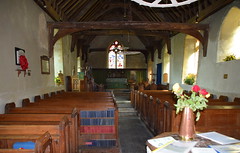  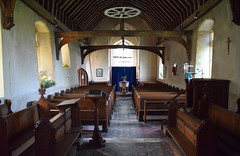
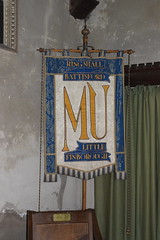 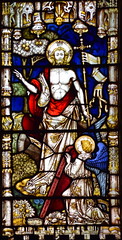 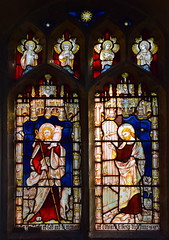 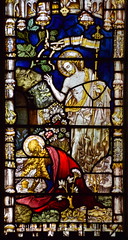 
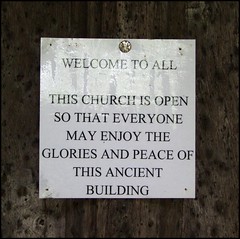 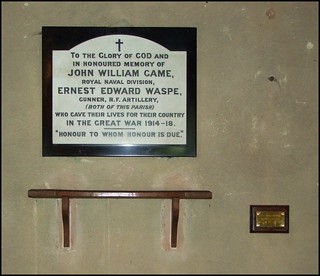
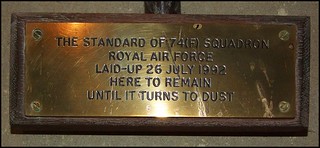
Amazon commission helps cover the running
costs of this site
|
|
|

